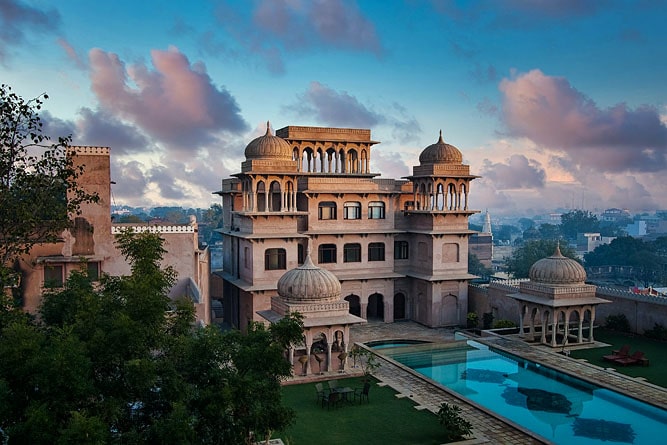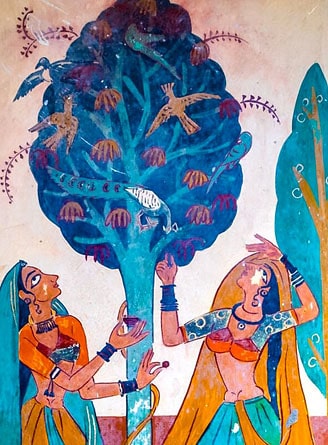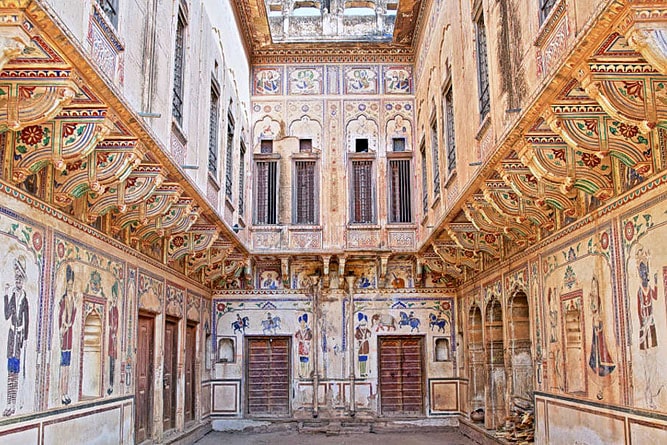Mandawa Havelis
Town with havelis in Shekhawati
must-see attraction
Address: Mandawa, Shekhawati, Rajasthan
Visit duration: People typically spend 1 to 1.5 days in the Shekhawati region


About Mandawa Havelis, Shekhawati
A small town in Rajasthan’s Shekhawati region, Mandawa is known as an ‘Open Art Gallery’ as it houses several havelis or merchant’s mansions that exude opulence and grandiosity. Mandawa is located close to the Silk Route which developed the area as a major trading spot for China and the Middle East in ancient India.
Mandawa is home to numerous havelis which were built as residential complexes for wealthy merchant families who lived in ancient Rajasthan. These havelis have a traditional look and feel with both exteriors and interiors decorated with mandala, mural and fresco artwork and Ragamala paintings.
The art style of murals and the mandalas showcase a blending of diverse themes. The Raagmala paintings of the havelis depict the folk tales of the region. It also portrays the lives of the merchants’ families. The paintings later evolved and incorporated European culture as portrayed through the paintings of motor cars, airplanes or gramophones.
Jhunjhunwala Haveli
The Jhunjhunwala Haveli was built in the mid-19th century by a rich Rajasthani merchant. This haveli is famous for its ‘Golden Room’ which is situated on the right side of the entrance gate. The paintings in this were done using a gold-leaf painting method where painters used melted gold to paint the pictures.
The haveli also features the traditional art of Rajasthan through paintings depicting different gods and goddesses. The lattice work on the windows and the fine carving craftsmanship on the wooden doors of the haveli are impressive. The haveli paints a vivid picture of the ancient Rajasthan era.
Chokhani Double Haveli
The Chokhani Double Haveli was built by two brothers of the Chokhani family, who were eminent merchants in the 20th century. The complex is divided from the centre into two havelis and both sides mirror each other and are connected through a small corridor. The haveli gets its name from this architecture.
The walls of the haveli are painted with pictures of Hindu gods, the Rajput kings, peacocks, sombre British soldiers, cars and men in western attire. The doors are made out of wood and showcase meticulously carved designs. The jaali designs are also incorporated into the architecture throughout the haveli. The haveli features a grand courtyard adjoining the two wings depicting the blending of Rajasthani culture with the influence of British culture on the Rajput rulers.
The present owners of the haveli migrated and settled in Calcutta.

Bansidhar Newatia Haveli
The Bansidhar Newatia Haveli was built in 1920. It now hosts one major bank in India.
This is one of the most luxurious havelis of Mandawa which alludes to the royal lifestyle of the Rajput rulers. The magnificent architecture incorporated with splendid designs and patterns, and the diligent handiwork of the haveli reflect the traditions, art and technology of the bygone era of Rajasthan.
This ancient yet modern haveli is different because of the fascinating contemporary artworks of past times. It is filled with captivating wall paintings like a boy using a telephone, the very first successful flight by the Wright brothers being watched by saree-clad women, a woman watching a European woman riding a chauffeur-driven car, a strongman hauling a car, and a bird-man flying in a winged device.
These vivid paintings and illustrations of the haveli make it unique among the other havelis of Mandawa. The drawings are noteworthy and deserve admiration.
Sneh Ram Ladia Haveli
The structure of the Sneh Ram Ladia Haveli is a mix of Rajasthani skills that were influenced by the English cultures. The walls of the haveli have paintings of lord Krishna and different arabesque designs and floral paintings on every side.
The Haveli has a faded illustration of the slaying of Ravana by Lord Rama along with other paintings like a man enjoying hookah and a procession frieze, Europeans in their guest room. The ancient artefacts which the royal inhabitants used are still retained inside the haveli, pausing time in the ancient era of Rajasthan.

Gulab Rai Ladia Haveli
This 18th-century Rajput haveli is among the most palatial havelis of Mandawa. The Gulab Rai Ladia Haveli is renowned for the contemporary artwork of realism and reality exhibited through exotic imagery and its mural paintings in varied themes.
The paintings of the haveli narrate the different phases of life. The canvas includes women giving birth, a Greek man, a horse riding a tiger and birds tendering their eggs. The exquisite artwork of latticed windows and carved wooden doors illustrates the adept craftsmanship of the Rajasthan artisans.
Mandawa Castle
According to the town's oral history, Thakur Nawal Singh built the Mandawa Castle to preserve the tradepost in the 18th century right in the middle of the town. It is the most significant complex because the entire town of Mandawa rises enclosing the castle.
The mosaic artwork on the interior walls and ceilings of the castle was inspired by the architectural artwork of Sheesh Mahal of Amber Fort. The castle has now transformed into a luxury heritage hotel decorated with a lush garden offering amenities like a pool, cocktail bar, ayurvedic spa, coffee shop and restaurant.

Facts and tips about Mandawa Havelis
- Mehdi Hassan, the renowned Ghazal Singer of South Asia, was born in the town of Mandawa.
- The hotels in Mandawa arrange tour guides, so ask the management of the lodge you are staying in to provide tour guides as there are several havelis to see at Mandawa.
- Some of the havelis require entry fees, some need permission to enter and some have no restrictions to take a tour.
How to reach Mandawa
The other main towns with havelis in Shekhawati (Nawalgarh, Fatehpur and Mahansar) are a 30-minute drive away from Mandawa. It takes about 3 to 3.5 hours to reach Mandawa from Jaipur or Bikaner. The trip from Delhi to Mandawa takes around 5 hours by car.
See location on Google Maps
Other attractions near Mandawa
- Fatehpur - 21 km
- Mahansar - 26 km
- Nawalgarh - 29 km
- Jaipur - 170 km
- Bikaner - 190 km
- Delhi - 267 km
FAQs about Mandawa Havelis
1. Is Mandawa worth visiting?
The town of art with diverse artworks should be a must on the bucket list while a trip to Rajasthan.
2. How many days are required to see the havelis?
Two days suffice if you want to enjoy the tour of the town and its famous attractions Mandawa and nearby towns to its fullest. However, one day will also be enough if you visit only the major tourist spots.
3. What is the best time to visit Mandawa Havelis?
The best time to visit Mandawa Havelis would be from October to March during the cooling seasons. However, the monsoon from July to September is also a pleasant time to visit the town. If you are visiting Mandawa in the summer, cotton attire is a must for your luggage.
4. What to buy from the town of Mandawa?
The best things to shop for in the town are glass bangles, dye fabrics, wooden furniture, handicraft products and historical paintings.

